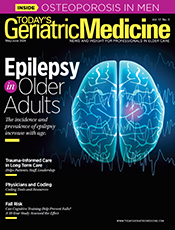
May/June 2024
May/June 2024 Issue Editor’s Note: Administrative Burdens Fuel Burnout Burnout—one of the latest buzzwords in medicine—is a widespread and still growing problem among clinicians, including physicians, nurses, social workers, pharmacists, and other health care providers. And while this sense of fatigue or overwhelm is often blamed on the pandemic, it has as much to do with the nature of institutions, systems, and technology. According to the American Medical Association, “While many factors contribute to burnout, the burnout epidemic is often associated with system inefficiencies, administrative burdens, and increased regulation and technology requirements.” Many clinicians point, particularly, to the burden of documentation—the subject of a future article in Today’s Geriatric Medicine—as a culprit in their experience of burnout. Time spent wrestling with EHR usability issues, ensuring regulatory compliance, and documenting patient encounters, for example, is time clinicians are not spending caring for their patients, meeting the needs of their families, enjoying leisure time, or engaging in self-care. For physicians, a great chunk of this documentation time is increasingly devoted to coding. Staffing shortages and other factors have piled coding duties on already harried doctors who have not only little time but, when it comes to coding, little training. In her feature article, “Physicians and Coding,” contributor Sue Coyle looks at the problem and at potential solutions, including artificial intelligence and autonomous coding. Look for more on these topics in future issues. Also in this issue are features on epilepsy, osteoporosis in men, and trauma-informed care in long term care, as well as articles on cognitive training for fall risk, remote monitoring for implanted heart devices, the latest technology for home therapy, and malnutrition and transitions of care. — Kate Jackson |
